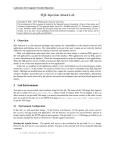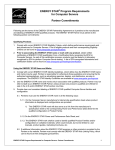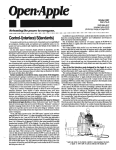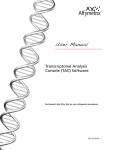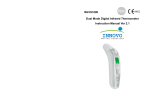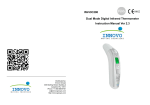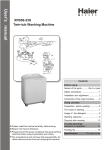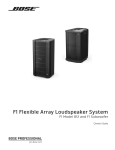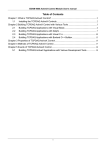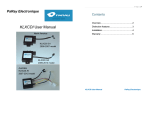Download ENERGY STAR Televisions V6.1 Specification
Transcript
ENERGY STAR® Program Requirements Product Specification for Televisions Eligibility Criteria Version 6.1 Following is the Final Version 6.1 ENERGY STAR Product Specification for Televisions. A product shall meet all of the identified criteria if it is to earn the ENERGY STAR. 1 DEFINITIONS A) Product Types: 1) Television (TV): A product designed to be powered primarily by mains power having a diagonal screen size of 15 inches or larger that is manufactured with a TV tuner, and that is capable of displaying dynamic visual information from wired or wireless sources including but not limited to: a) Broadcast and similar services for terrestrial, cable, satellite, and/or broadband transmission of analog and/or digital signals; b) Display-specific data connections, such as Video Graphics Array (VGA), Digital Visual Interface (DVI), High-Definition Multimedia Interface (HDMI), DisplayPort; c) Media storage devices such as a USB flash drive, a memory card, or a DVD; or d) Network connections, usually using Internet Protocol, typically carried over Ethernet or WiFi. A TV may contain, but is not limited to, one of the following display technologies: liquid crystal 1 display (LCD) , organic light-emitting diode (OLED), cathode-ray tube (CRT), or plasma display panel (PDP). 2) Rear-projection TV: A television product in which the display device is a projector that focuses images onto a screen located inside the TV enclosure. 3) Direct-view TV: A television product in which the display device emits light either directly from the screen surface or transmits light from a source mounted directly behind the screen. 4) TV Combination Unit: A television product in which the TV and one or more additional devices (e.g., DVD player, Blu-ray Disc player, Hard Disk Drive) are combined into a single enclosure, and which meets all of the following criteria: a) It is not possible to measure the power of the individual components without removing the product housing; and b) The product connects to a wall outlet via a single power cord. 5) Component Television: A television product composed of two or more separate components (e.g., display device and tuner) that is marketed and sold as a television under a single model or system designation. A component television may have more than one power cord. 6) Hospitality Television: A television product which includes the following features: 1 Includes LED- and cold-cathode fluorescent lamp (CCFL)-backlit LCD displays. ENERGY STAR Program Requirements for Televisions – Eligibility Criteria Page 1 of 12 a) A control port for bi-directional communication (DB-9, RJ11, RJ12, RJ45, coaxial cable, or HDMI-CEC); b) Activated hospitality protocol software (e.g., SmartPort, MPI, MTI, Serial Protocol) to provide direct access to Video-On-Demand (VOD) systems or a digital media player designed for hospitality-specific applications; and c) A power state that meets the definition of Download Acquisition Mode. 7) Analog Television: A television product which has an NTSC, PAL, or SECAM tuner, and may have analog video inputs (e.g., composite video, component video, S-video, RGB). 8) Digital Television: A television product which has at least one digital tuner or at least one digital video input (e.g., HDMI). Products with an analog tuner and both analog and digital inputs are considered digital products under this specification. B) Additional Functions: Functions that are not required for the basic operation of the device. Additional functions include, but are not limited to, a VCR unit, a DVD unit, an HDD unit, a FM-radio unit, a memory card-reader unit, or an ambient lighting unit. C) Default Picture Setting (or Home Picture Setting): The picture setting which is recommended by the manufacturer from the initial set up menu or the mode that the television comes shipped in if no setting is recommended. D) Brightest Selectable Preset Picture Setting (or Retail Picture Setting): The preset picture setting in which the TV produces the highest luminance within either the home or retail configuration. E) Native Vertical Resolution: The physical pixel count for the vertical axis of the television (e.g., a television with a screen resolution of 1920 x 1080 (horizontal x vertical) would have a native vertical resolution of 1080). F) Electronic Program Guide (EPG): An interactive on-screen menu of TV program information downloaded from an external source (e.g., program time, date, descriptions). G) External Power Supply (EPS): Also referred to as External Power Adapter. A component contained in a separate physical enclosure external to the television casing, designed to convert line voltage ac input from the mains to lower dc voltage(s) in order to provide power to the television. An EPS connects to the television via a removable or hard-wired male/female electrical connection, cable, cord or other wiring. H) Point of Deployment (POD) Module: A conditional access module for digital cable signal reception. I) Luminance: The photometric measure of the luminous intensity per unit area of light traveling in a 2 given direction, expressed in units of candelas per square meter (cd/m ). J) Automatic Brightness Control (ABC): The self-acting mechanism that controls the brightness of a display as a function of ambient light. K) Operational Modes: 1) On Mode: The power mode in which the product is connected to a mains power source, has been activated, and is providing one or more of its principal functions. ENERGY STAR Program Requirements for Televisions – Eligibility Criteria Page 2 of 12 a) Power Overhang State: A limited-duration power state within On Mode that is intended to facilitate a product’s rapid return to full On Mode functionality or provide time for the product to perform functions required for safe shutdown (e.g., operation of cooling fans) after being switched into a low power state by the user. 2) Standby-Passive Mode: The mode in which the TV is connected to a power source, produces neither sound nor picture, but can be switched into another mode with the remote control unit or an internal signal. 3) Standby-Active, High Mode: The mode in which the TV is connected to a power source, produces neither sound nor picture, but can be switched into another mode with the remote control unit or an internal signal, and with an external signal, and is exchanging/receiving data with/from an external source. a) Download Acquisition Mode (DAM): The power mode in which the product is connected to a mains power source, produces neither sound nor picture, and is actively downloading data. Data downloads may include channel listing information for use by an electronic programming guide, TV setup data, channel map updates, firmware updates, monitoring for emergency messaging/communications or other network communications. 4) Standby-Active, Low Mode: The mode in which the TV is connected to a power source, produces neither sound nor picture, but can be switched into another mode with the remote control unit or an internal signal, and with an external signal, and is not exchanging/receiving data with/from an external source. 5) Off Mode: The mode where the TV is connected to a power source, produces neither sound nor picture, and cannot be switched into any other mode with the remote control unit, an internal signal, or an external signal. L) Screen Area: The viewable screen area of the product, calculated by multiplying the viewable image width by the viewable image height. M) Product Family: A group of product models that are: (1) made by the same manufacturer; (2) subject to the same ENERGY STAR qualification criteria; and (3) of a common basic design. Product models within a family differ from each other according to one or more characteristics or features that either (1) have no impact on product performance with regard to ENERGY STAR qualification criteria, or (2) are specified herein as acceptable variations within a product family. For Televisions, acceptable variations within a product family include: 1) Color, and 2) Housing. N) Unit Under Test (UUT): The unit currently undergoing testing. O) Local Area Network (LAN): Multiple clients interconnected in a geographical area. P) Wide Area Network (WAN): Network that is not limited by geographical area, usually interconnecting multiple local networks. Q) NOPR Test: U.S. Department of Energy (DOE) Notice of Proposed Rulemaking Energy Conservation Program: Test Procedures for Television Sets published in the Federal Register, 77 FR 2864 on January 19, 2012. ENERGY STAR Program Requirements for Televisions – Eligibility Criteria Page 3 of 12 R) Final Rule Test: U.S. Department of Energy (DOE) Final Rule Energy Conservation Program: Test Procedures for Television Sets incorporated into the Code of Federal Regulation, 10 CFR § 430.23(h) and Appendix H to Subpart B 10 CFR § 430, on November 25, 2013. 2 SCOPE 2.1 2.1.1 Included Products Products that are: (1) marketed to the consumer as a television (e.g., television is the primary function); (2) capable of being powered from either a wall outlet or a battery unit that is sold with an external power supply; and (3) meet one of the following product type definitions, are eligible for ENERGY STAR qualification, with the exception of products listed in Section 2.2: i. ii. iii. iv. v. Televisions Television Combination Units Component Televisions Hospitality Televisions Products with a computer input port (e.g., VGA) that are marketed and sold primarily as televisions. vi. Dual-function televisions / computer monitors that are marketed and sold as dual-function televisions / computer monitors. 2.2 Excluded Products 2.2.1 Products that are covered under other ENERGY STAR product specifications are not eligible for qualification under this specification. The list of specifications currently in effect can be found at www.energystar.gov/specifications. 2.2.2 Products that satisfy one or more of the following conditions are not eligible for ENERGY STAR qualification under this specification: i. ii. Products with a computer input port (e.g., VGA) that are marketed and sold primarily as computer monitors, Products that do not have a power state meeting the definition of Standby-Passive Mode (e.g., Public Alert CEA-2009-A certified models which offer 24/7/365 active public alert features), with the exception of Hospitality Televisions that meet the requirements specified in Section 3.8. 3 QUALIFICATION CRITERIA 3.1 Significant Digits and Rounding 3.1.1 All calculations shall be carried out with directly measured (unrounded) values. 3.1.2 Unless otherwise specified, compliance with specification limits shall be evaluated using exact values without any benefit from further rounding. 3.1.3 Directly measured or calculated values that are submitted for reporting on the ENERGY STAR website shall be rounded to the nearest significant digit as expressed in the corresponding specification limit. ENERGY STAR Program Requirements for Televisions – Eligibility Criteria Page 4 of 12 3.2 3.2.1 General Requirements External Power Supply (EPS): If the product is shipped with an EPS, the EPS shall meet the level V performance requirements under the International Efficiency Marking Protocol and include the level V marking. Additional information on the Marking Protocol is available at www.energystar.gov/powersupplies. i. 3.2.2 External Power Supplies shall meet level V requirements when tested using the Test Method for Calculating the Energy Efficiency of Single-Voltage External Ac-Dc and Ac-Ac Power Supplies, Aug. 11, 2004. User Information: The product shall ship with consumer informational materials located in either (1) the hard copy or electronic user manual, or (2) a package or box insert. These materials shall include: i. ii. Information about the ENERGY STAR program, Information on the energy consumption implications of changes to default as-shipped television configuration and settings, and iii. Notification that enabling certain optional features and functionalities (e.g., instant-on), may increase energy consumption beyond the limits required for ENERGY STAR qualification, as applicable. 3.2.3 Forced Menu: Any product that includes a forced menu upon initial start-up shall: i. ii. 3.2.4 Pre-set Picture Setting Menu: Any product where consumers have the option of selecting different picture settings from a preset menu at any time shall: i. 3.2.5 3.3 3.3.1 Provide users with a choice of “home” picture setting or “retail” picture setting. Partners may use alternative terminology if approved by EPA. Upon selection of “retail” picture setting at initial start-up, either (1) display a second prompt requiring the user to confirm the choice of “retail” picture setting, or (2) display information on the start-up menu that the “home” picture setting is the setting in which the product qualifies for ENERGY STAR. If option (2) is selected, additional detail about ENERGY STAR qualification and energy consumption expectations shall be included in printed product literature and on the product information page on the Partner’s website. Display information that the Default Picture Setting (the Default Picture Setting in “home” mode for TVs with a forced menu) reflects the settings under which the product qualifies for the ENERGY STAR. For example, such information may be indicated by including the ENERGY STAR mark in the name or description of that picture setting or in the form of a message displayed each time any setting other than the default picture setting is selected. Component Televisions: For component television products, the total power of all components shall be considered for evaluation against any power requirement in this specification. On Mode Requirements For products with Automatic Brightness Control (ABC) enabled by default and whose performance is validated using one of the test methods outlined in Section 4.3 (i.e. NOPR Test or Final Rule Test), On Mode power with ABC (PON_ABC), as calculated per NOPR Test Equation 1 or per Final Rule Test Equation 1 shall be less than or equal to the Maximum On Mode Power Requirement (PON_MAX), as calculated per Equation 2. ENERGY STAR Program Requirements for Televisions – Eligibility Criteria Page 5 of 12 NOPR Test Equation 1: Calculation of Maximum On Mode Power for Products with ABC Enabled by Default PON_ABC = (0.55 × P300) + (0.45 × P0) Where: PON_ A B C is the calculated On Mode power with ABC enabled by default, P300 is the measured On Mode power with ABC enabled when tested at 300 lux per Section 5.5 of the NOPR, P0 is the measured On Mode power with ABC enabled when tested per Section 5.5 of the NOPR, but with 0 lux entering the sensor. Final Rule Test Equation 1: Calculation of Maximum On Mode Power for Products with ABC Enabled by Default PON_ABC = (0.25 × P100) + (0.25 × P35) + (0.25 × P12) + (0.25 × P3) Where: PON_ A B C is the calculated On Mode power with ABC enabled by default, P100, P35, P12,and P3 are the measured On Mode power values at 100, 35, 12, and 3 lux , respectively, with ABC enabled when tested per the Final Rule . 3.3.2 For products that do not offer ABC, products that do not offer ABC enabled by default, or products with ABC enabled by default and whose ABC sensor does not meet the validation criteria set forth in Section 4.3, On Mode power with ABC disabled (PON), as measured per the ENERGY STAR test method shall be less than or equal to the Maximum On Mode Power Requirement (PON_MAX), as calculated per Equation 2. Equation 2: Calculation of Maximum On Mode Power Requirement PON _ MAX = 100 tanh(0.00085 ( A - 140) 0.052) 14.1 Where: PON_MAX is the maximum allowable On Mode Power consumption in W, A is the viewable screen area of the product in square inches tanh is the hyperbolic tangent function 3.3.3 3.4 Measured Power Overhang State power shall be less than or equal to the Maximum On Mode Power Requirement (PON_MAX), as calculated per Equation 2. Standby-Passive Mode Requirements 3.4.1 Measured Standby-Passive Mode power (PSTANDBY-PASSIVE) shall be less than or equal to 1.0 W. 3.4.2 For products that offer more than one Standby-Passive Mode, the Standby-Passive Mode with the lowest power consumption shall be enabled by default. 3.5 3.5.1 3.6 Standby-Active, Low Mode Requirements For products that offer network connectivity, Standby-Active, Low Mode with network connectivity enabled shall be measured and reported. Luminance Requirements ENERGY STAR Program Requirements for Televisions – Eligibility Criteria Page 6 of 12 3.6.1 NOPR Test: Measured peak luminance in the “home” (or default, as shipped) picture setting (L HOME) shall be greater than or equal to 65% of measured peak luminance in the “retail” (or brightest-selectable preset picture setting (L RETAIL). 3.6.2 Final Rule Test: Measured peak luminance in the Default Picture Setting (L DEFAULT_HOME) shall be greater than or equal to 65% of measured peak luminance in the Brightest Selectable Preset Picture Setting (the greater value of L DEFAULT_RETAIL or L BRIGHTEST_HOME). 3.7 3.7.1 Download Acquisition Mode (DAM) Requirements A product may automatically exit Standby-Passive Mode and enter Download Acquisition Mode according to a predefined schedule, in order to: i. Download channel listing information for use by an electronic programming guide, ii. Monitor for emergency messaging/communications, or iii. Communicate via a network protocol. 3.7.2 3.8 3.8.1 Measured DAM energy consumption for all DAM states (EDAM) shall be less than or equal to 40 watt-hours per day (0.04 kWh/day). Hospitality Television Requirements Hospitality Television TEC (TECHOSP), as calculated per Equation 3, shall be less than or equal to the Maximum Hospitality Television TEC Requirement (TECHOSP_MAX), as calculated per Equation 4. Equation 3: Calculation of TEC for Hospitality Televisions (TECHOSP) TEC HOSP PON 5 PSTANDBY PASSIVE 19 EDAM Where: TECHOSP is the calculated Hospitality Television TEC; PON is the measured On Mode power; PSTANDBY-PASSIVE is the measured Standby-Passive Mode power; and EDAM is the measured DAM energy over a 24 hour period. Equation 4: Calculation of Maximum TEC Requirement for Hospitality Televisions (TECHOSP_MAX) TECHOSP _ MAX = 500 tanh(0.00085 ( A - 140) 0.052) 129.5 Where: TECHOSP_MAX is the maximum allowable TEC for Hospitality Televisions; A is the viewable screen area of the product in square inches tanh is the hyperbolic tangent function 3.8.2 For Hospitality Televisions that feature an always-on DAM, measured DAM power (PDAM) shall be less than or equal to 1.0 W when tested per the Standby-Passive Mode test procedure. ENERGY STAR Program Requirements for Televisions – Eligibility Criteria Page 7 of 12 Note: Products intended for sale in the US market are subject to minimum toxicity and recyclability requirements. Please see ENERGY STAR Program Requirements for Televisions: Partner Commitments for details. 4 TESTING 4.1.1 On Mode, Standby-Passive Mode, Luminance, and DAM Testing 4.1.2 When testing On Mode, Standby-Passive Mode, Luminance, and DAM for Television products, the test methods identified in Table 1 shall be used to determine ENERGY STAR qualification. Table 1: Test Method for ENERGY STAR Qualification Product Type Ac Mains-powered Televisions Main Battery-powered Televisions Test Method EITHER The Notice of Proposed Rulemaking (NOPR) Test Procedures for Television Sets published in the Federal Register, 77 FR 2864 OR the Final Rule Test Procedures for Television Sets incorporated in Appendix H to Subpart B of 10 CFR § 430 and 10 CFR § 429.25 (Federal Register 78 FR 63823 October 25, 2013) ENERGY STAR Test Method for Televisions, Rev. Aug2010 Note: Hospitality TVs with Download Acquisition Mode (DAM) electing to use the Final Rule test procedure must also use Section 5.3, Guidance for Implementation of CEA: Procedure for DAM Testing, in the ENERGY STAR Test Method for Televisions, Rev. Aug-2010 to test DAM. Note: According to DOE, after April 23, 2013 representations with respect to the energy use or efficiency of television sets must be made in accordance with tests conducted pursuant to the new DOE test procedure (Appendix H to Subpart B of 10 CFR Part 430 along with 10 CFR Part 429.25), and therefore, manufacturers may wish to begin using this new test procedure immediately to avoid duplicative testing to update their energy representations. 4.2 4.2.1 Standby-Active, Low Mode Testing NOPR Test: i. UUT (Unit Under Test) Configuration and Control a) Network Connection Capabilities: i) Verify the UUT has network connection capabilities: i. Network connections should be listed in the user manual. If no connections are specified in the user manual, verify that the TV does not have network capabilities by checking for the absence of physical connections or the absence of network settings in the menu. ENERGY STAR Program Requirements for Televisions – Eligibility Criteria Page 8 of 12 ii. If the UUT has the capabilities to be connected to a network but was not shipped with a required piece of hardware (e.g. wireless adapter), that connection type shall not be tested. b) Peripherals and Network Connections: ii) UUT connections shall be set up as follows: i. If a physical network connection is present, network connectivity is listed in the TV menu, or listed in the user manual; the UUT network capabilities shall be activated and the UUT shall be connected to a Local Area Network (LAN) prior to being placed into standby mode. ii. The LAN shall allow devices to ping other devices on the network but will not allow access to a wide area network (WAN). Note: Limiting the connection to a LAN ensures that the UUT is in Standby-Active, Low Mode, where it is connected to a network but does not receive external data. The LAN, including wireless Radio Frequency (RF), shall support the highest and lowest data speeds of the UUT’s network function. iii) If the UUT has multiple network connections (e.g., Wi-Fi, Ethernet, other), the UUT shall be configured and connected to a single network source in accordance with the hierarchy of connections listed below2, while maintaining a video signal connection (i.e., connected to a video signal generating device). i. Wi-Fi (Institution of Electrical and Electronics Engineers - IEEE 802.112007)3 ii. Ethernet (IEEE 802.3). If the UUT supports Energy Efficient Ethernet (IEEE 802.3az-2010)4 then it shall be connected to a device that also supports IEEE 802.3az. iii. Other ii. Power Measurement: c) Measurement Procedure5: iv) After the TV is placed into Standby-Active, Low Mode, leave the UUT for a minimum of 30 minutes to allow Standby-Active, Low Mode power to stabilize. v) Measure the average power consumed for a 10 minute period. Record the power for Standby-Active, Low Mode. 2 This order of preference may change in future revisions. IEEE 802 – Telecommunications and information exchange between systems – Local and metropolitan area networks – Part 11: Wireless LAN Medium Access Control (MAC) and Physical Layer (PHY) Specifications 4 Part 3: Carrier Sense Multiple Access with Collision Detection (CSMA/CD) Access Method and Physical Layer Specifications - Amendment 5: Media Access Control Parameters, Physical Layers, and Management Parameters for Energy-Efficient Ethernet 5 Measurement procedure is based on Standby-Passive measurements in Section 8.6.5.8 of IEC 620872011 3 ENERGY STAR Program Requirements for Televisions – Eligibility Criteria Page 9 of 12 4.2.2 Final Rule Test: i. 4.3 4.3.1 Test according to the Final Rule Test Procedures for Television Sets (Appendix H to Subpart B of 10 CFR § 430). ABC Sensor Validation Testing NOPR Test: the average power measured at 50 lux (P50) shall increase by at least 5% relative to the average power measured at 10 lux (P10), the average power measured at 100 lux shall increase by at least 5% relative to the average power measured at 50 lux (P50), and the average power measured at 300 lux (P300) shall be greater than or equal to the average power measured at 100 lux (P100), as indicated in Equation 5. Equation 5: ABC Sensor Validation Conditions Where: Pn is the Power consumed for On Mode with ABC enabled at n lux, with a direct light source 4.3.2 4.4 4.4.1 Final Rule Test: ABC Sensor Validation is not required. Number of Units Required for Testing For all products, Representative Models shall be selected for testing per the following requirements: i. ii. 4.4.2 4.5 4.5.1 For qualification of an individual product model, a product configuration equivalent to that which is intended to be marketed and labeled as ENERGY STAR is considered the Representative Model; For qualification of a Product Family, any product configuration within the family may be considered the Representative Model. For products tested per the Final Rule, units shall be selected for testing per the sampling requirements defined in 10 CFR § 429.25, which references 10 CFR § 429.11. International Market Qualification Products shall be tested for qualification at the relevant input voltage/frequency combination for each market in which they will be sold and promoted as ENERGY STAR. 5 USER INTERFACE 5.1.1 Partners are encouraged to design products in accordance with the user interface standard IEEE 1621: Standard for User Interface Elements in Power Control of Electronic Devices Employed in Office/Consumer Environments. For details, see http://eetd.LBL.gov/Controls. ENERGY STAR Program Requirements for Televisions – Eligibility Criteria Page 10 of 12 6 EFFECTIVE DATE 6.1.1 Effective Date: The Version 6 ENERGY STAR Televisions specification shall take effect on June 1, 2013. To qualify for ENERGY STAR, a product model shall meet the ENERGY STAR specification in effect on its date of manufacture. The date of manufacture is specific to each unit and is the date on which a unit is considered to be completely assembled. 6.1.2 Future Specification Revisions: EPA reserves the right to change this specification should technological and/or market changes affect its usefulness to consumers, industry, or the environment. In keeping with current policy, revisions to the specification are arrived at through stakeholder discussions. In the event of a specification revision, please note that the ENERGY STAR qualification is not automatically granted for the life of a product model. 7 CONSIDERATIONS FOR FUTURE REVISIONS 7.1.1 On Mode Power for Products with ABC Disabled: EPA is interested in understanding better the On Mode power consumption of ABC products when the ABC feature is disabled. EPA anticipates exploring this issue in the next specification revision. ENERGY STAR Program Requirements for Televisions – Eligibility Criteria Page 11 of 12 APPENDIX A: Sample Calculations Viewable Diagonal Screen Size (inches) Aspect Ratio Viewable Screen Size, w x l (Inches) Screen Area, A (sq-inches) PON_MAX (watts) 20 16:9 17.4 x 9.8 170.9 21.9 32 16:9 27.9 x 15.7 437.6 43.7 42 16:9 36.6 x 20.6 753.8 65.9 50 16:9 43.6 x 24.5 1068.2 82.7 60 16:9 52.3 x 29.4 1538.3 98.7 ENERGY STAR Program Requirements for Televisions – Eligibility Criteria Page 12 of 12















